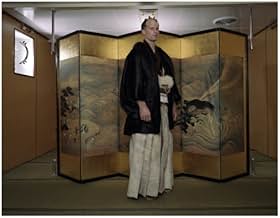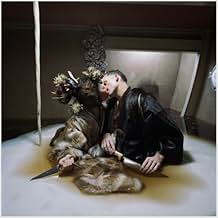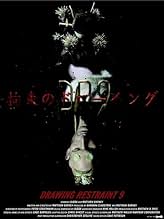AVALIAÇÃO DA IMDb
6,5/10
1,6 mil
SUA AVALIAÇÃO
Adicionar um enredo no seu idiomaThe film concerns the theme of self-imposed limitation and continues Matthew Barney's interest in religious rite, this time focusing on Shinto.The film concerns the theme of self-imposed limitation and continues Matthew Barney's interest in religious rite, this time focusing on Shinto.The film concerns the theme of self-imposed limitation and continues Matthew Barney's interest in religious rite, this time focusing on Shinto.
- Prêmios
- 1 indicação no total
Avaliações em destaque
There's no dialogue for a while, and then there's some Japanese dialogue, and all the while, I didn't really know what was going on. I was lost at pretty much all times, but that was to be expected. This had "avant-garde" written all over it, and for being an art piece, I guess it's sporadically interesting. It probably achieves what it sets out to do, but whatever that is feels unclear to me. If you want to dive in, there's probably a lot to chew on, but as to whether it would taste any good, who knows. Probably not. But it's challenging. That's more of an observation rather than something that makes it bad or good. And there's some music here composed by Bjork, though she didn't do all the music it seems. I don't know.
That's my take away. I don't know.
That's my take away. I don't know.
DR9 shouldn't really be thought of as a film in the traditional sense of the word, nor should it sit alone, its part of a greater work of art, the clue is in the title! To really appreciate the film it helps to see it in relation to sculpture and the way objects interact within a chosen space. also the resonance of ritual and especially Japanese shinto can bring a certain amount of meaning and clarity to some of the more obscure sequences in the film. even though it seems very 'serious and arty' on the surface ,there is humour and romance and the film! try not to see it as a finite static thing, but something that can change according to the multiple layers you allow yourself to perceive it on.
To hear Matthew Barney interviewed, saying things like "I will continue to manipulate space in film," you would think that he has nothing on his mind but process. Yet the evolution of Drawing Restraint 9 is spiritual, not formal. DR9, in fact, is a complete repudiation of the noxious Ayn Rand-stinking cosmology of the Cremaster films. Freud has been replaced by Jung, and Hegel by Kierkegaard. This is a Barney film that could bring you to tears. Any doubts about whether he's an artist or fraud are laid to rest by this film -- frauds do not grow, they just keep along the same path.
I had my doubts about the Cremaster films ( except for Cremaster 2, still the most uncanny piece on Barney's resume ) The first hour and a half of Drawing Restraint 9 had me squirming, sure that Barney was unmasking himself as a joke once and for all. All of Barney's faults are on display -- the crude appropriation and dim understanding of other cultures and myths, the glossy yet flat cinematography that would only look stylish to a reader of Vogue, the hunch that the only movie he's ever seen is The Shining, and a generally unfocused feeling, as if he's casting around for meaning that isn't there. And then, of course, there are those endless shots of men doing their work, building a better future, creating that obelisk to the sky! Except here the bumbleheaded Hegelian philosophy of history-in-action was even more boring because of the documentary trappings. Instead of showing a legless woman strap on a blade and chop potatoes, a metaphor for a half-completed action, we see real men doing real jobs. Only occasionally Barney has them producing one of his symbols, or sticks a blue feathered afro on top of a tanker, so that we know these seemingly mundane tasks will eventually have vaguely triumphant, Wagnerian results.
Then, suddenly -- if you can speak of suddenness in a film like this, and I think you can -- the Japanese men start loading a harpoon gun and firing nasty spikes at nasty speeds into the sea. And you realize that what you took to be another Barney paean to progress has crumbled. We are now sailing in deep hippie waters, my friend. And the sailing is good. Barney and Bjork retire to a tatami-matted cabin and the film begins to go places the Cremaster films would never dare. The cinematographer suddenly discovers shadow and grain-texture. Bjork's uninspired score becomes hypnotic. A feeling of death, doubt, and failure creeps into the film, as a Japanese sage tells a story of a primal scar made by the collision of two ships, while Barney and Bjork are posed with the edge of a whale statue separating them. The personal, the political, the spiritual and the mythical start to engage in supercollision.
The film seems to have been conceived as an exercise in humility, repentance for the colossal egotism of the Cremaster films. Barney takes pains to highlight his new bald spot, making him look like a tonsured monk, there is a nude scene which proves he is no Vincent Gallo, and -- most memorably -- Barney speaks! As a studly silent mannequin in the Cremaster films, he had mystery, but here he lets you in on the dirty little secret: He has the geekiest voice in history, almost like how a castrato would talk in daily conversation. Listen closer, however, and he sounds almost angelic...
This new humility, which may have roots in marriage troubles or encroaching baldness -- the root of insight is often just this shallow -- justifies the Asiatic trappings. But Barney is hiding his real light under a bushel. It is a Western religion that truly moves him these days. There are a "trinity" ( hint hint ) of symbols consisting of whale ambergris, pomegranate seeds and shrimp whose meaning I won't spoil for you. Except to say that Barney is calling you a shrimp. And asking you to be a whale. The "restraint" of the title starts to feel a whole lot more like renunciation, and the inner joys it brings.
Life is fair after all: It costs ten dollars for a ticket to DR9, and unless you're a zombie, you will get more pleasure and consolation from this film than any billionaire computer-peddler could get out of one of Barney's vaseline tubs.
I had my doubts about the Cremaster films ( except for Cremaster 2, still the most uncanny piece on Barney's resume ) The first hour and a half of Drawing Restraint 9 had me squirming, sure that Barney was unmasking himself as a joke once and for all. All of Barney's faults are on display -- the crude appropriation and dim understanding of other cultures and myths, the glossy yet flat cinematography that would only look stylish to a reader of Vogue, the hunch that the only movie he's ever seen is The Shining, and a generally unfocused feeling, as if he's casting around for meaning that isn't there. And then, of course, there are those endless shots of men doing their work, building a better future, creating that obelisk to the sky! Except here the bumbleheaded Hegelian philosophy of history-in-action was even more boring because of the documentary trappings. Instead of showing a legless woman strap on a blade and chop potatoes, a metaphor for a half-completed action, we see real men doing real jobs. Only occasionally Barney has them producing one of his symbols, or sticks a blue feathered afro on top of a tanker, so that we know these seemingly mundane tasks will eventually have vaguely triumphant, Wagnerian results.
Then, suddenly -- if you can speak of suddenness in a film like this, and I think you can -- the Japanese men start loading a harpoon gun and firing nasty spikes at nasty speeds into the sea. And you realize that what you took to be another Barney paean to progress has crumbled. We are now sailing in deep hippie waters, my friend. And the sailing is good. Barney and Bjork retire to a tatami-matted cabin and the film begins to go places the Cremaster films would never dare. The cinematographer suddenly discovers shadow and grain-texture. Bjork's uninspired score becomes hypnotic. A feeling of death, doubt, and failure creeps into the film, as a Japanese sage tells a story of a primal scar made by the collision of two ships, while Barney and Bjork are posed with the edge of a whale statue separating them. The personal, the political, the spiritual and the mythical start to engage in supercollision.
The film seems to have been conceived as an exercise in humility, repentance for the colossal egotism of the Cremaster films. Barney takes pains to highlight his new bald spot, making him look like a tonsured monk, there is a nude scene which proves he is no Vincent Gallo, and -- most memorably -- Barney speaks! As a studly silent mannequin in the Cremaster films, he had mystery, but here he lets you in on the dirty little secret: He has the geekiest voice in history, almost like how a castrato would talk in daily conversation. Listen closer, however, and he sounds almost angelic...
This new humility, which may have roots in marriage troubles or encroaching baldness -- the root of insight is often just this shallow -- justifies the Asiatic trappings. But Barney is hiding his real light under a bushel. It is a Western religion that truly moves him these days. There are a "trinity" ( hint hint ) of symbols consisting of whale ambergris, pomegranate seeds and shrimp whose meaning I won't spoil for you. Except to say that Barney is calling you a shrimp. And asking you to be a whale. The "restraint" of the title starts to feel a whole lot more like renunciation, and the inner joys it brings.
Life is fair after all: It costs ten dollars for a ticket to DR9, and unless you're a zombie, you will get more pleasure and consolation from this film than any billionaire computer-peddler could get out of one of Barney's vaseline tubs.
I originally saw this at it's Toronto Film Festival premiere. I went alone and allowed myself to be drawn in slowly, almost becoming hypnotized by it. The film is like a long, bizarre, beautiful dream that made me feel like I was high on some wonderful drug.
The imagery is stunning, inspired! Bjork's soundtrack is perfect. Both Barney and Bjork provide compelling performances. What more can be said except see this film and let it speak to you. Its a wonderful opportunity to see some experimental film by a truly gifted artist (or pair of artists, including Bjork's significant contributions)
Take a chance, it'll be worth it.
The imagery is stunning, inspired! Bjork's soundtrack is perfect. Both Barney and Bjork provide compelling performances. What more can be said except see this film and let it speak to you. Its a wonderful opportunity to see some experimental film by a truly gifted artist (or pair of artists, including Bjork's significant contributions)
Take a chance, it'll be worth it.
As with reading all comments, you will find it useful to know where the writer is placed. I have watched the first "Cremaster" and Barney's entry in the "Destricted" compilation. That latter piece was a failure in my mind. There's not much overlap between the sculptural and the cinematic anyway. One is more on the noun side, the other on the verb side: contextual, environmental. I admire that he tried to find that commonality in the erotic, but the result is rather sophomoric in all but the initial choices.
This isn't wonderful either. I hold hope for the later "Cremaster" experiences, that there will be some valuable conversation between us. This is a wholly different thing altogether. This man has found his love, and has created a valentine. Its a conversation, an intercourse between the two of them. The value we are expected to get is in witnessing rather than participating.
The forms he has chosen are all Japanese because they have developed an observational distance with the ordinary things of their life we do not have.
The basic urge here is the melding of the two lives: Bjarney, but with careful, artificial constraints. We have the merging of the tea ceremony with the whaling ritual; the reversal of rendering blubber to whaleoil to the coagulation of pseudoblubber from pseudowhaleoil.
We have the melding of humans with whales, ambergris with pearls, constructing whale icons with consumption...
And of course the conflating of Barney's sculptural objects with Japanese ritualistic ones. I am not well enough versed in details of Japanese esoterica to know where one starts and the other stops, but I suppose in his view it is perfectly balanced, one "restraining" the other; one "drawing" the other, each drawing restraints on another level: tea to whale and so on.
The most engaging sequence is at the beginning: three phenomenal episodes: one the wrapping of two packages, bodies; a second the procession of the whale oil returned and ritual construction thereupon; and finally a dive into the water seeking marine truth, revealing a hot blade (seen later as the humans transform into whales).
Its not for us, they made this. Its a conversation of love and commitment between the two. We've only crew members.
Ted's Evaluation -- 3 of 3: Worth watching.
This isn't wonderful either. I hold hope for the later "Cremaster" experiences, that there will be some valuable conversation between us. This is a wholly different thing altogether. This man has found his love, and has created a valentine. Its a conversation, an intercourse between the two of them. The value we are expected to get is in witnessing rather than participating.
The forms he has chosen are all Japanese because they have developed an observational distance with the ordinary things of their life we do not have.
The basic urge here is the melding of the two lives: Bjarney, but with careful, artificial constraints. We have the merging of the tea ceremony with the whaling ritual; the reversal of rendering blubber to whaleoil to the coagulation of pseudoblubber from pseudowhaleoil.
We have the melding of humans with whales, ambergris with pearls, constructing whale icons with consumption...
And of course the conflating of Barney's sculptural objects with Japanese ritualistic ones. I am not well enough versed in details of Japanese esoterica to know where one starts and the other stops, but I suppose in his view it is perfectly balanced, one "restraining" the other; one "drawing" the other, each drawing restraints on another level: tea to whale and so on.
The most engaging sequence is at the beginning: three phenomenal episodes: one the wrapping of two packages, bodies; a second the procession of the whale oil returned and ritual construction thereupon; and finally a dive into the water seeking marine truth, revealing a hot blade (seen later as the humans transform into whales).
Its not for us, they made this. Its a conversation of love and commitment between the two. We've only crew members.
Ted's Evaluation -- 3 of 3: Worth watching.
Você sabia?
- Trilhas sonorasGratitude
Written by Björk and Matthew Barney
Vocal by Will Oldham
Harp played by Zeena Parkins
Celeste played by Jónas Sen
Keyboard played by Nico Muhly
Arranging & editing by Björk
Programming by Björk and Valgeir Sigurðsson
Produced by Björk
Principais escolhas
Faça login para avaliar e ver a lista de recomendações personalizadas
- How long is Drawing Restraint 9?Fornecido pela Alexa
Detalhes
- Data de lançamento
- Países de origem
- Central de atendimento oficial
- Idiomas
- Também conhecido como
- Растворение мира
- Locações de filme
- Empresa de produção
- Consulte mais créditos da empresa na IMDbPro
Bilheteria
- Faturamento bruto nos EUA e Canadá
- US$ 234.743
- Fim de semana de estreia nos EUA e Canadá
- US$ 18.011
- 2 de abr. de 2006
- Faturamento bruto mundial
- US$ 267.275
- Tempo de duração
- 2 h 15 min(135 min)
- Cor
- Mixagem de som
- Proporção
- 1.85 : 1
Contribua para esta página
Sugerir uma alteração ou adicionar conteúdo ausente























